Comprehensive Report on Acute Otitis Media: Diagnosis and Management
VerifiedAdded on 2022/05/25
|10
|2559
|53
Report
AI Summary
This report provides a comprehensive overview of Acute Otitis Media (AOM) in children, a common ear infection, including its epidemiology, pathophysiology, and diagnostic methods. It explores the challenges in accurate diagnosis, especially in young children, and discusses the evolution of treatment strategies, from antibiotics to alternative approaches. The report delves into the importance of otoscopy and the guidelines for diagnosis, emphasizing the need for accurate assessment. It also covers the management methods, including pain control, and considers cultural, spiritual, and socioeconomic factors. The report concludes with a discussion on the rationale behind specific treatment choices, emphasizing the complexities of AOM diagnosis and the importance of comprehensive patient care.
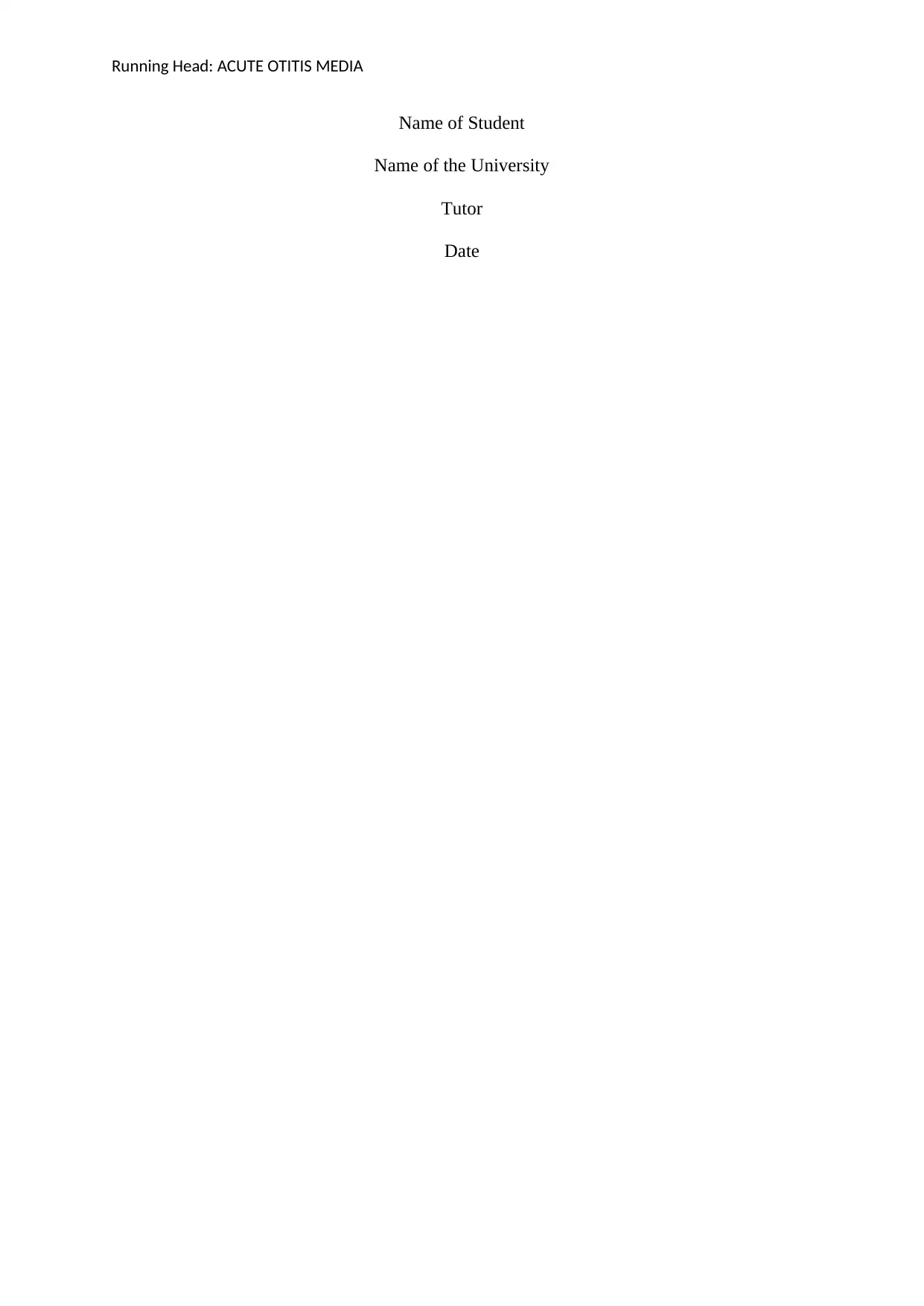
Running Head: ACUTE OTITIS MEDIA
Name of Student
Name of the University
Tutor
Date
Name of Student
Name of the University
Tutor
Date
Paraphrase This Document
Need a fresh take? Get an instant paraphrase of this document with our AI Paraphraser
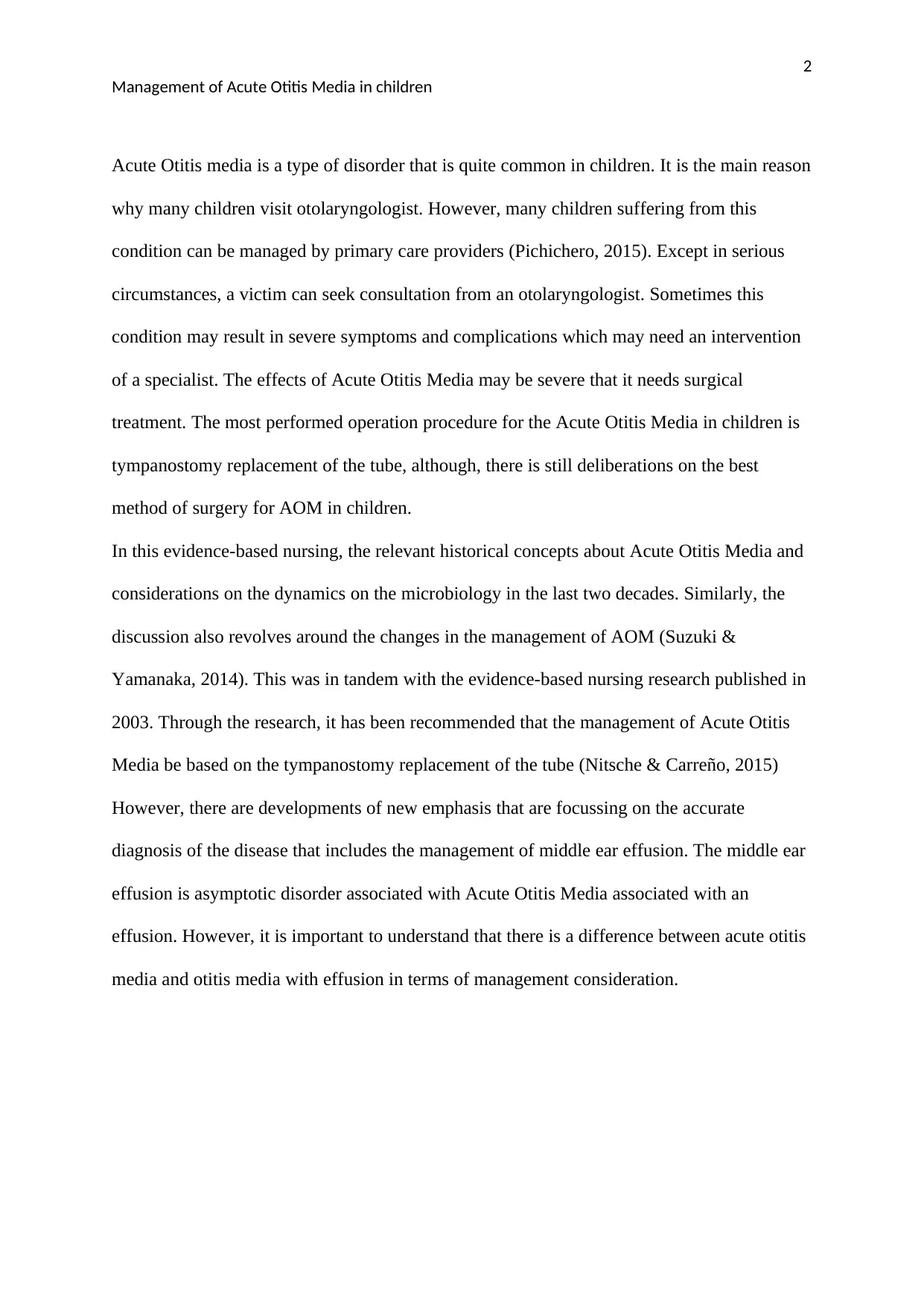
2
Management of Acute Otitis Media in children
Acute Otitis media is a type of disorder that is quite common in children. It is the main reason
why many children visit otolaryngologist. However, many children suffering from this
condition can be managed by primary care providers (Pichichero, 2015). Except in serious
circumstances, a victim can seek consultation from an otolaryngologist. Sometimes this
condition may result in severe symptoms and complications which may need an intervention
of a specialist. The effects of Acute Otitis Media may be severe that it needs surgical
treatment. The most performed operation procedure for the Acute Otitis Media in children is
tympanostomy replacement of the tube, although, there is still deliberations on the best
method of surgery for AOM in children.
In this evidence-based nursing, the relevant historical concepts about Acute Otitis Media and
considerations on the dynamics on the microbiology in the last two decades. Similarly, the
discussion also revolves around the changes in the management of AOM (Suzuki &
Yamanaka, 2014). This was in tandem with the evidence-based nursing research published in
2003. Through the research, it has been recommended that the management of Acute Otitis
Media be based on the tympanostomy replacement of the tube (Nitsche & Carreño, 2015)
However, there are developments of new emphasis that are focussing on the accurate
diagnosis of the disease that includes the management of middle ear effusion. The middle ear
effusion is asymptotic disorder associated with Acute Otitis Media associated with an
effusion. However, it is important to understand that there is a difference between acute otitis
media and otitis media with effusion in terms of management consideration.
Management of Acute Otitis Media in children
Acute Otitis media is a type of disorder that is quite common in children. It is the main reason
why many children visit otolaryngologist. However, many children suffering from this
condition can be managed by primary care providers (Pichichero, 2015). Except in serious
circumstances, a victim can seek consultation from an otolaryngologist. Sometimes this
condition may result in severe symptoms and complications which may need an intervention
of a specialist. The effects of Acute Otitis Media may be severe that it needs surgical
treatment. The most performed operation procedure for the Acute Otitis Media in children is
tympanostomy replacement of the tube, although, there is still deliberations on the best
method of surgery for AOM in children.
In this evidence-based nursing, the relevant historical concepts about Acute Otitis Media and
considerations on the dynamics on the microbiology in the last two decades. Similarly, the
discussion also revolves around the changes in the management of AOM (Suzuki &
Yamanaka, 2014). This was in tandem with the evidence-based nursing research published in
2003. Through the research, it has been recommended that the management of Acute Otitis
Media be based on the tympanostomy replacement of the tube (Nitsche & Carreño, 2015)
However, there are developments of new emphasis that are focussing on the accurate
diagnosis of the disease that includes the management of middle ear effusion. The middle ear
effusion is asymptotic disorder associated with Acute Otitis Media associated with an
effusion. However, it is important to understand that there is a difference between acute otitis
media and otitis media with effusion in terms of management consideration.
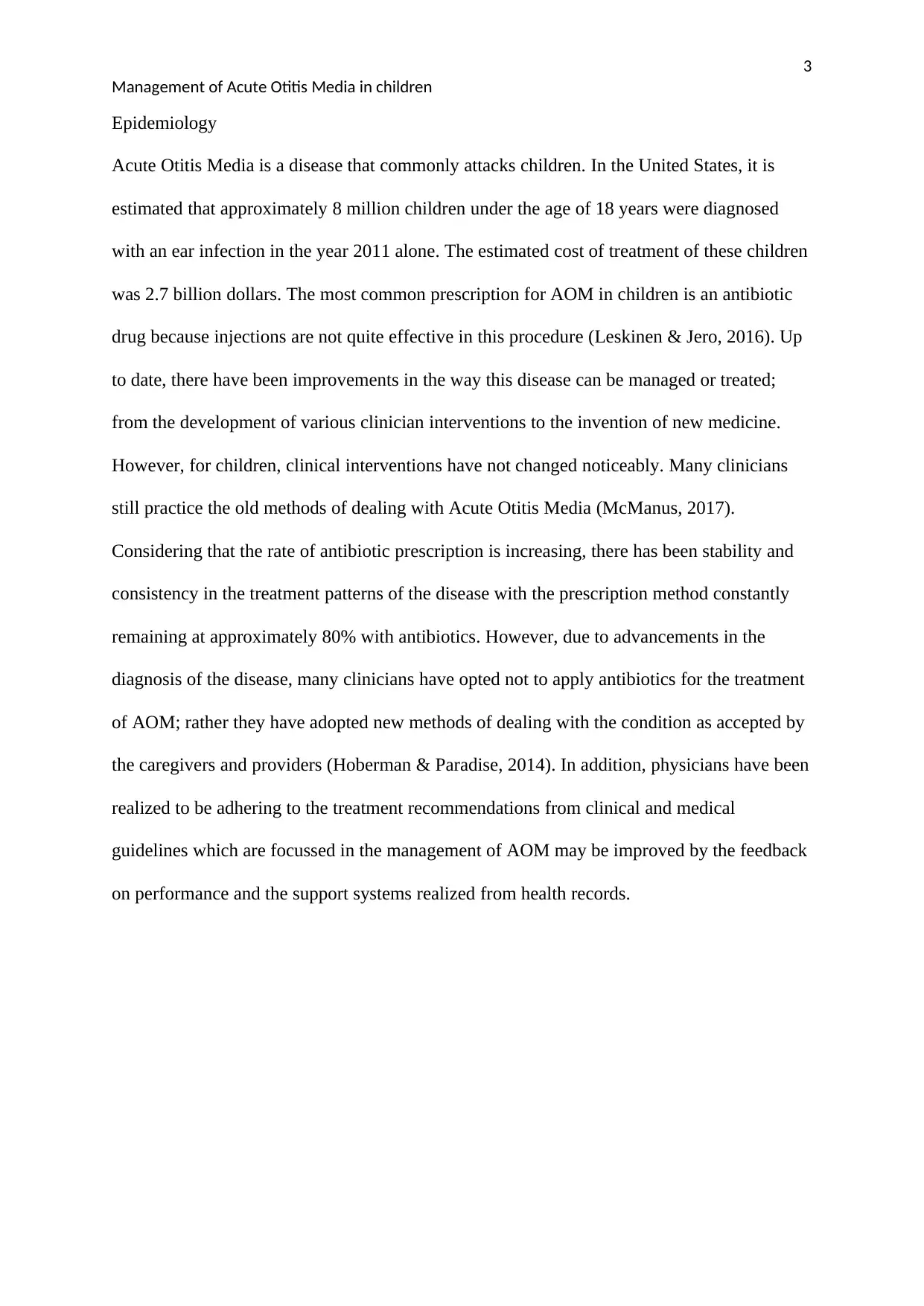
3
Management of Acute Otitis Media in children
Epidemiology
Acute Otitis Media is a disease that commonly attacks children. In the United States, it is
estimated that approximately 8 million children under the age of 18 years were diagnosed
with an ear infection in the year 2011 alone. The estimated cost of treatment of these children
was 2.7 billion dollars. The most common prescription for AOM in children is an antibiotic
drug because injections are not quite effective in this procedure (Leskinen & Jero, 2016). Up
to date, there have been improvements in the way this disease can be managed or treated;
from the development of various clinician interventions to the invention of new medicine.
However, for children, clinical interventions have not changed noticeably. Many clinicians
still practice the old methods of dealing with Acute Otitis Media (McManus, 2017).
Considering that the rate of antibiotic prescription is increasing, there has been stability and
consistency in the treatment patterns of the disease with the prescription method constantly
remaining at approximately 80% with antibiotics. However, due to advancements in the
diagnosis of the disease, many clinicians have opted not to apply antibiotics for the treatment
of AOM; rather they have adopted new methods of dealing with the condition as accepted by
the caregivers and providers (Hoberman & Paradise, 2014). In addition, physicians have been
realized to be adhering to the treatment recommendations from clinical and medical
guidelines which are focussed in the management of AOM may be improved by the feedback
on performance and the support systems realized from health records.
Management of Acute Otitis Media in children
Epidemiology
Acute Otitis Media is a disease that commonly attacks children. In the United States, it is
estimated that approximately 8 million children under the age of 18 years were diagnosed
with an ear infection in the year 2011 alone. The estimated cost of treatment of these children
was 2.7 billion dollars. The most common prescription for AOM in children is an antibiotic
drug because injections are not quite effective in this procedure (Leskinen & Jero, 2016). Up
to date, there have been improvements in the way this disease can be managed or treated;
from the development of various clinician interventions to the invention of new medicine.
However, for children, clinical interventions have not changed noticeably. Many clinicians
still practice the old methods of dealing with Acute Otitis Media (McManus, 2017).
Considering that the rate of antibiotic prescription is increasing, there has been stability and
consistency in the treatment patterns of the disease with the prescription method constantly
remaining at approximately 80% with antibiotics. However, due to advancements in the
diagnosis of the disease, many clinicians have opted not to apply antibiotics for the treatment
of AOM; rather they have adopted new methods of dealing with the condition as accepted by
the caregivers and providers (Hoberman & Paradise, 2014). In addition, physicians have been
realized to be adhering to the treatment recommendations from clinical and medical
guidelines which are focussed in the management of AOM may be improved by the feedback
on performance and the support systems realized from health records.
⊘ This is a preview!⊘
Do you want full access?
Subscribe today to unlock all pages.

Trusted by 1+ million students worldwide
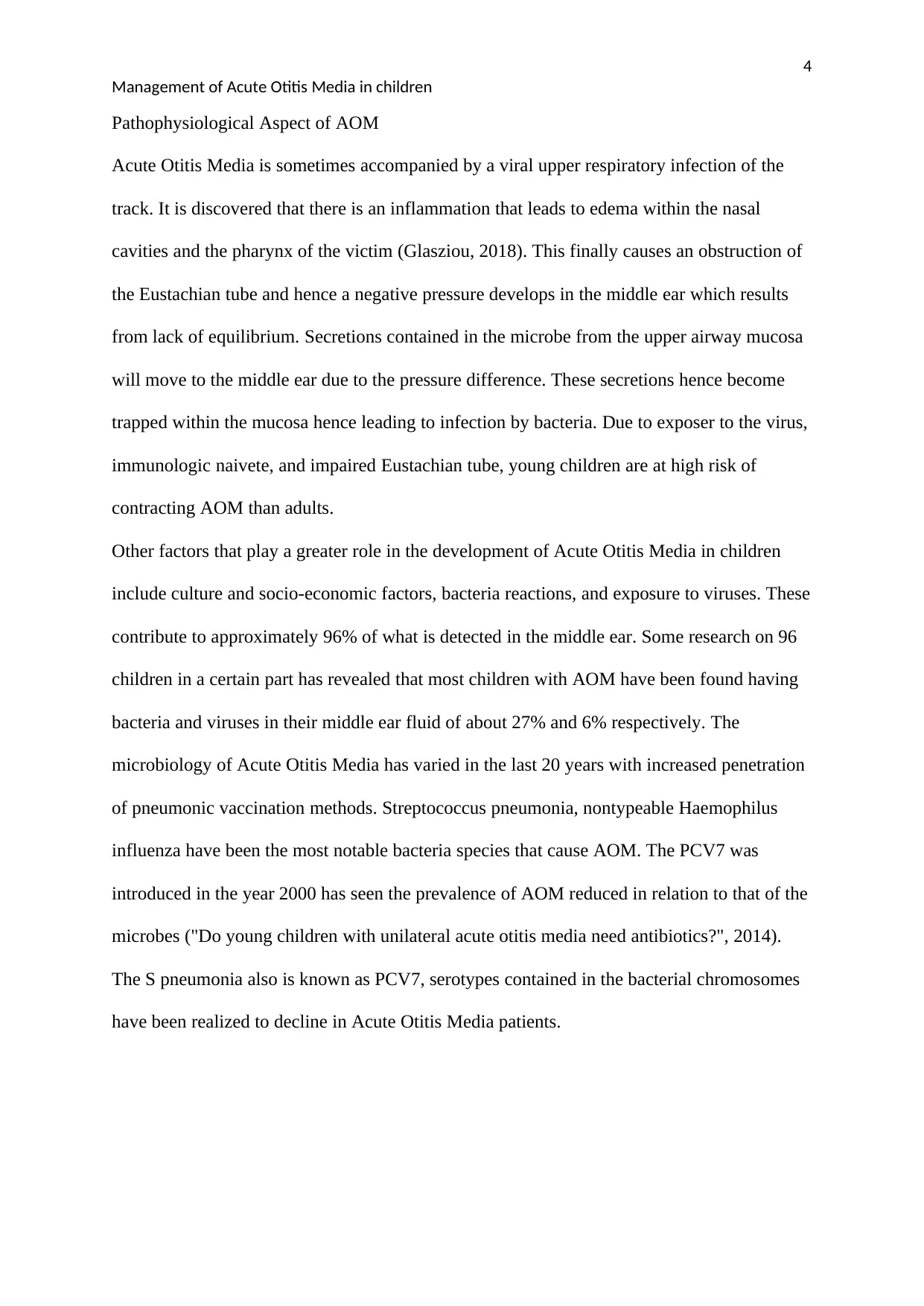
4
Management of Acute Otitis Media in children
Pathophysiological Aspect of AOM
Acute Otitis Media is sometimes accompanied by a viral upper respiratory infection of the
track. It is discovered that there is an inflammation that leads to edema within the nasal
cavities and the pharynx of the victim (Glasziou, 2018). This finally causes an obstruction of
the Eustachian tube and hence a negative pressure develops in the middle ear which results
from lack of equilibrium. Secretions contained in the microbe from the upper airway mucosa
will move to the middle ear due to the pressure difference. These secretions hence become
trapped within the mucosa hence leading to infection by bacteria. Due to exposer to the virus,
immunologic naivete, and impaired Eustachian tube, young children are at high risk of
contracting AOM than adults.
Other factors that play a greater role in the development of Acute Otitis Media in children
include culture and socio-economic factors, bacteria reactions, and exposure to viruses. These
contribute to approximately 96% of what is detected in the middle ear. Some research on 96
children in a certain part has revealed that most children with AOM have been found having
bacteria and viruses in their middle ear fluid of about 27% and 6% respectively. The
microbiology of Acute Otitis Media has varied in the last 20 years with increased penetration
of pneumonic vaccination methods. Streptococcus pneumonia, nontypeable Haemophilus
influenza have been the most notable bacteria species that cause AOM. The PCV7 was
introduced in the year 2000 has seen the prevalence of AOM reduced in relation to that of the
microbes ("Do young children with unilateral acute otitis media need antibiotics?", 2014).
The S pneumonia also is known as PCV7, serotypes contained in the bacterial chromosomes
have been realized to decline in Acute Otitis Media patients.
Management of Acute Otitis Media in children
Pathophysiological Aspect of AOM
Acute Otitis Media is sometimes accompanied by a viral upper respiratory infection of the
track. It is discovered that there is an inflammation that leads to edema within the nasal
cavities and the pharynx of the victim (Glasziou, 2018). This finally causes an obstruction of
the Eustachian tube and hence a negative pressure develops in the middle ear which results
from lack of equilibrium. Secretions contained in the microbe from the upper airway mucosa
will move to the middle ear due to the pressure difference. These secretions hence become
trapped within the mucosa hence leading to infection by bacteria. Due to exposer to the virus,
immunologic naivete, and impaired Eustachian tube, young children are at high risk of
contracting AOM than adults.
Other factors that play a greater role in the development of Acute Otitis Media in children
include culture and socio-economic factors, bacteria reactions, and exposure to viruses. These
contribute to approximately 96% of what is detected in the middle ear. Some research on 96
children in a certain part has revealed that most children with AOM have been found having
bacteria and viruses in their middle ear fluid of about 27% and 6% respectively. The
microbiology of Acute Otitis Media has varied in the last 20 years with increased penetration
of pneumonic vaccination methods. Streptococcus pneumonia, nontypeable Haemophilus
influenza have been the most notable bacteria species that cause AOM. The PCV7 was
introduced in the year 2000 has seen the prevalence of AOM reduced in relation to that of the
microbes ("Do young children with unilateral acute otitis media need antibiotics?", 2014).
The S pneumonia also is known as PCV7, serotypes contained in the bacterial chromosomes
have been realized to decline in Acute Otitis Media patients.
Paraphrase This Document
Need a fresh take? Get an instant paraphrase of this document with our AI Paraphraser
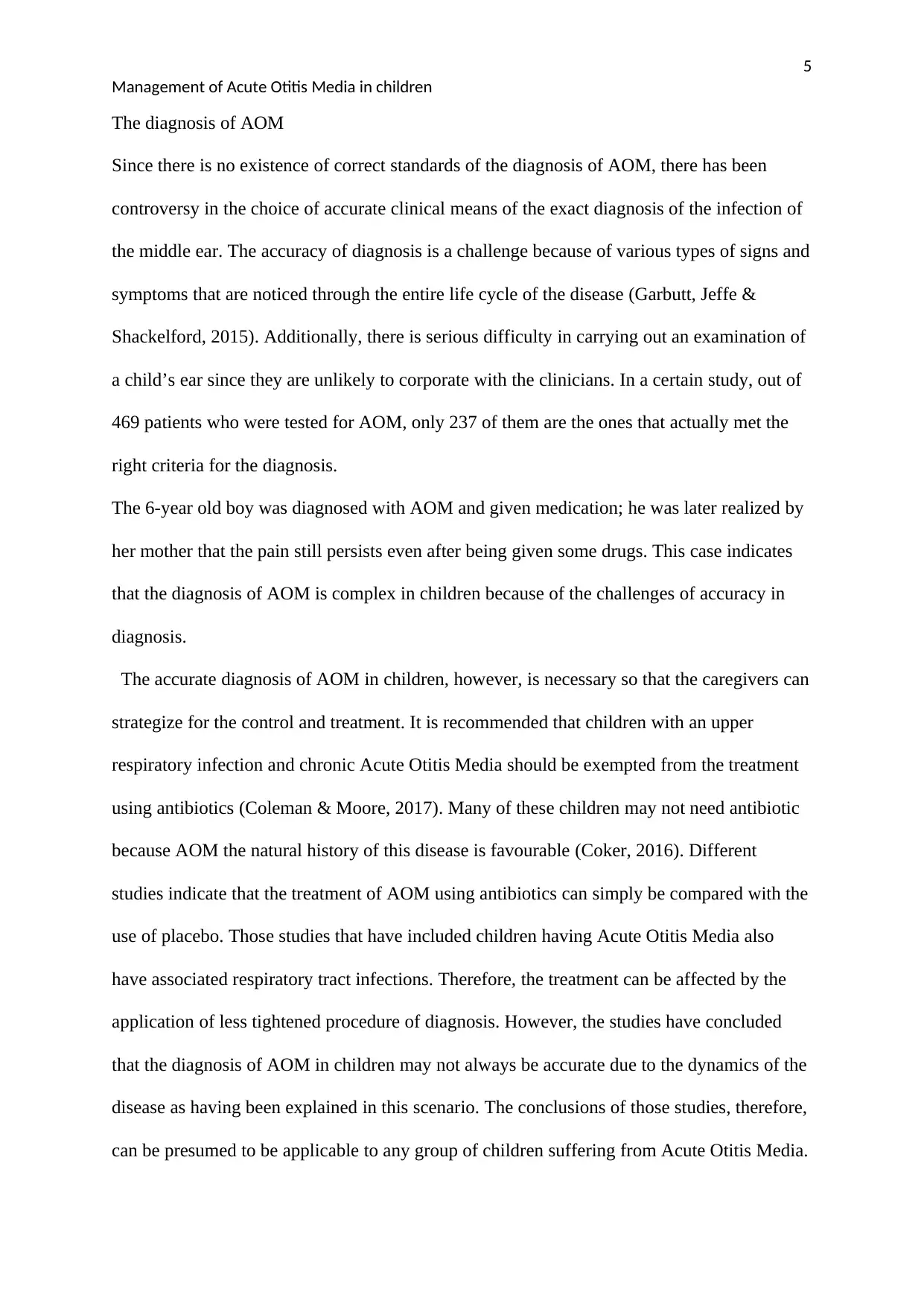
5
Management of Acute Otitis Media in children
The diagnosis of AOM
Since there is no existence of correct standards of the diagnosis of AOM, there has been
controversy in the choice of accurate clinical means of the exact diagnosis of the infection of
the middle ear. The accuracy of diagnosis is a challenge because of various types of signs and
symptoms that are noticed through the entire life cycle of the disease (Garbutt, Jeffe &
Shackelford, 2015). Additionally, there is serious difficulty in carrying out an examination of
a child’s ear since they are unlikely to corporate with the clinicians. In a certain study, out of
469 patients who were tested for AOM, only 237 of them are the ones that actually met the
right criteria for the diagnosis.
The 6-year old boy was diagnosed with AOM and given medication; he was later realized by
her mother that the pain still persists even after being given some drugs. This case indicates
that the diagnosis of AOM is complex in children because of the challenges of accuracy in
diagnosis.
The accurate diagnosis of AOM in children, however, is necessary so that the caregivers can
strategize for the control and treatment. It is recommended that children with an upper
respiratory infection and chronic Acute Otitis Media should be exempted from the treatment
using antibiotics (Coleman & Moore, 2017). Many of these children may not need antibiotic
because AOM the natural history of this disease is favourable (Coker, 2016). Different
studies indicate that the treatment of AOM using antibiotics can simply be compared with the
use of placebo. Those studies that have included children having Acute Otitis Media also
have associated respiratory tract infections. Therefore, the treatment can be affected by the
application of less tightened procedure of diagnosis. However, the studies have concluded
that the diagnosis of AOM in children may not always be accurate due to the dynamics of the
disease as having been explained in this scenario. The conclusions of those studies, therefore,
can be presumed to be applicable to any group of children suffering from Acute Otitis Media.
Management of Acute Otitis Media in children
The diagnosis of AOM
Since there is no existence of correct standards of the diagnosis of AOM, there has been
controversy in the choice of accurate clinical means of the exact diagnosis of the infection of
the middle ear. The accuracy of diagnosis is a challenge because of various types of signs and
symptoms that are noticed through the entire life cycle of the disease (Garbutt, Jeffe &
Shackelford, 2015). Additionally, there is serious difficulty in carrying out an examination of
a child’s ear since they are unlikely to corporate with the clinicians. In a certain study, out of
469 patients who were tested for AOM, only 237 of them are the ones that actually met the
right criteria for the diagnosis.
The 6-year old boy was diagnosed with AOM and given medication; he was later realized by
her mother that the pain still persists even after being given some drugs. This case indicates
that the diagnosis of AOM is complex in children because of the challenges of accuracy in
diagnosis.
The accurate diagnosis of AOM in children, however, is necessary so that the caregivers can
strategize for the control and treatment. It is recommended that children with an upper
respiratory infection and chronic Acute Otitis Media should be exempted from the treatment
using antibiotics (Coleman & Moore, 2017). Many of these children may not need antibiotic
because AOM the natural history of this disease is favourable (Coker, 2016). Different
studies indicate that the treatment of AOM using antibiotics can simply be compared with the
use of placebo. Those studies that have included children having Acute Otitis Media also
have associated respiratory tract infections. Therefore, the treatment can be affected by the
application of less tightened procedure of diagnosis. However, the studies have concluded
that the diagnosis of AOM in children may not always be accurate due to the dynamics of the
disease as having been explained in this scenario. The conclusions of those studies, therefore,
can be presumed to be applicable to any group of children suffering from Acute Otitis Media.
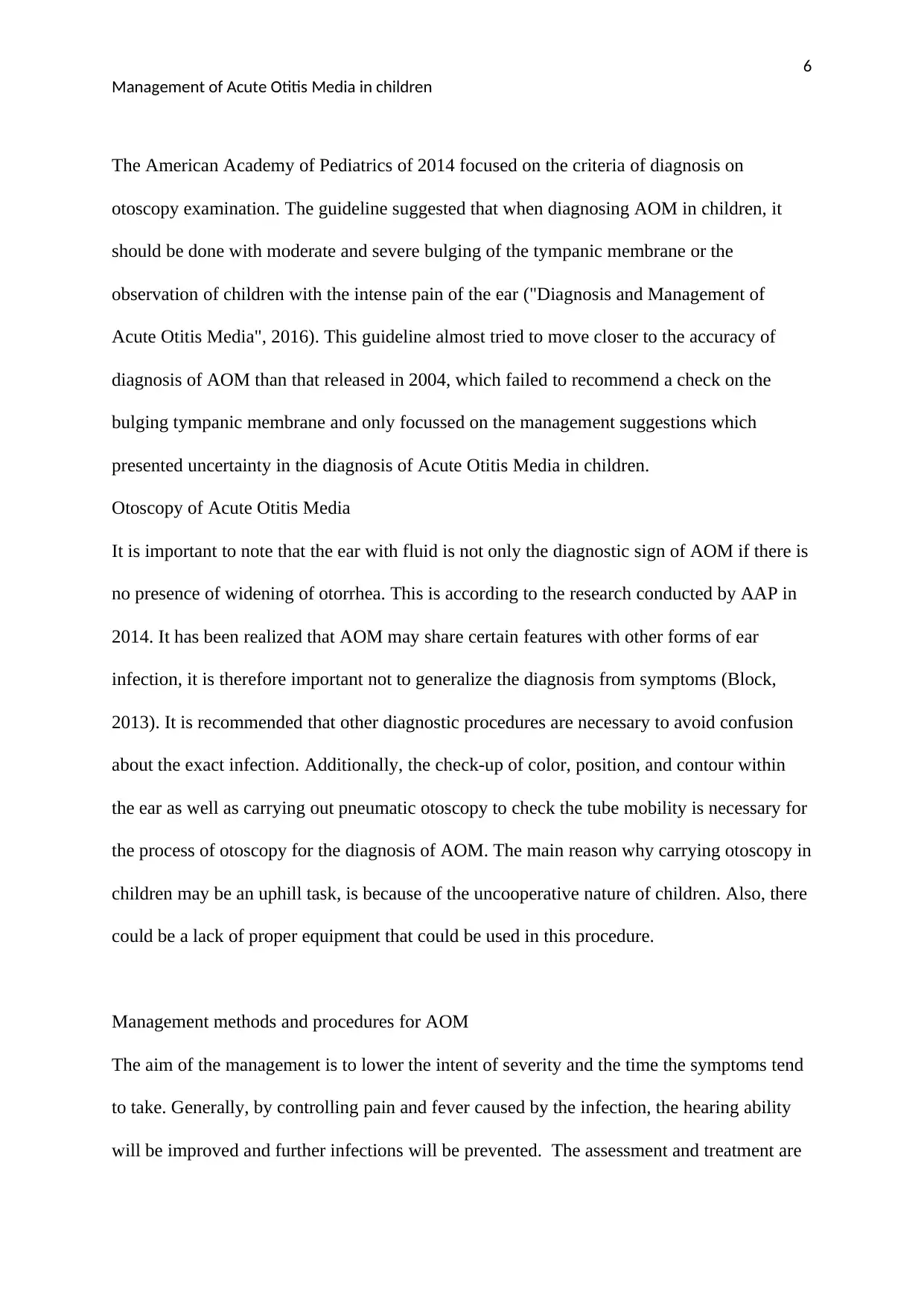
6
Management of Acute Otitis Media in children
The American Academy of Pediatrics of 2014 focused on the criteria of diagnosis on
otoscopy examination. The guideline suggested that when diagnosing AOM in children, it
should be done with moderate and severe bulging of the tympanic membrane or the
observation of children with the intense pain of the ear ("Diagnosis and Management of
Acute Otitis Media", 2016). This guideline almost tried to move closer to the accuracy of
diagnosis of AOM than that released in 2004, which failed to recommend a check on the
bulging tympanic membrane and only focussed on the management suggestions which
presented uncertainty in the diagnosis of Acute Otitis Media in children.
Otoscopy of Acute Otitis Media
It is important to note that the ear with fluid is not only the diagnostic sign of AOM if there is
no presence of widening of otorrhea. This is according to the research conducted by AAP in
2014. It has been realized that AOM may share certain features with other forms of ear
infection, it is therefore important not to generalize the diagnosis from symptoms (Block,
2013). It is recommended that other diagnostic procedures are necessary to avoid confusion
about the exact infection. Additionally, the check-up of color, position, and contour within
the ear as well as carrying out pneumatic otoscopy to check the tube mobility is necessary for
the process of otoscopy for the diagnosis of AOM. The main reason why carrying otoscopy in
children may be an uphill task, is because of the uncooperative nature of children. Also, there
could be a lack of proper equipment that could be used in this procedure.
Management methods and procedures for AOM
The aim of the management is to lower the intent of severity and the time the symptoms tend
to take. Generally, by controlling pain and fever caused by the infection, the hearing ability
will be improved and further infections will be prevented. The assessment and treatment are
Management of Acute Otitis Media in children
The American Academy of Pediatrics of 2014 focused on the criteria of diagnosis on
otoscopy examination. The guideline suggested that when diagnosing AOM in children, it
should be done with moderate and severe bulging of the tympanic membrane or the
observation of children with the intense pain of the ear ("Diagnosis and Management of
Acute Otitis Media", 2016). This guideline almost tried to move closer to the accuracy of
diagnosis of AOM than that released in 2004, which failed to recommend a check on the
bulging tympanic membrane and only focussed on the management suggestions which
presented uncertainty in the diagnosis of Acute Otitis Media in children.
Otoscopy of Acute Otitis Media
It is important to note that the ear with fluid is not only the diagnostic sign of AOM if there is
no presence of widening of otorrhea. This is according to the research conducted by AAP in
2014. It has been realized that AOM may share certain features with other forms of ear
infection, it is therefore important not to generalize the diagnosis from symptoms (Block,
2013). It is recommended that other diagnostic procedures are necessary to avoid confusion
about the exact infection. Additionally, the check-up of color, position, and contour within
the ear as well as carrying out pneumatic otoscopy to check the tube mobility is necessary for
the process of otoscopy for the diagnosis of AOM. The main reason why carrying otoscopy in
children may be an uphill task, is because of the uncooperative nature of children. Also, there
could be a lack of proper equipment that could be used in this procedure.
Management methods and procedures for AOM
The aim of the management is to lower the intent of severity and the time the symptoms tend
to take. Generally, by controlling pain and fever caused by the infection, the hearing ability
will be improved and further infections will be prevented. The assessment and treatment are
⊘ This is a preview!⊘
Do you want full access?
Subscribe today to unlock all pages.

Trusted by 1+ million students worldwide
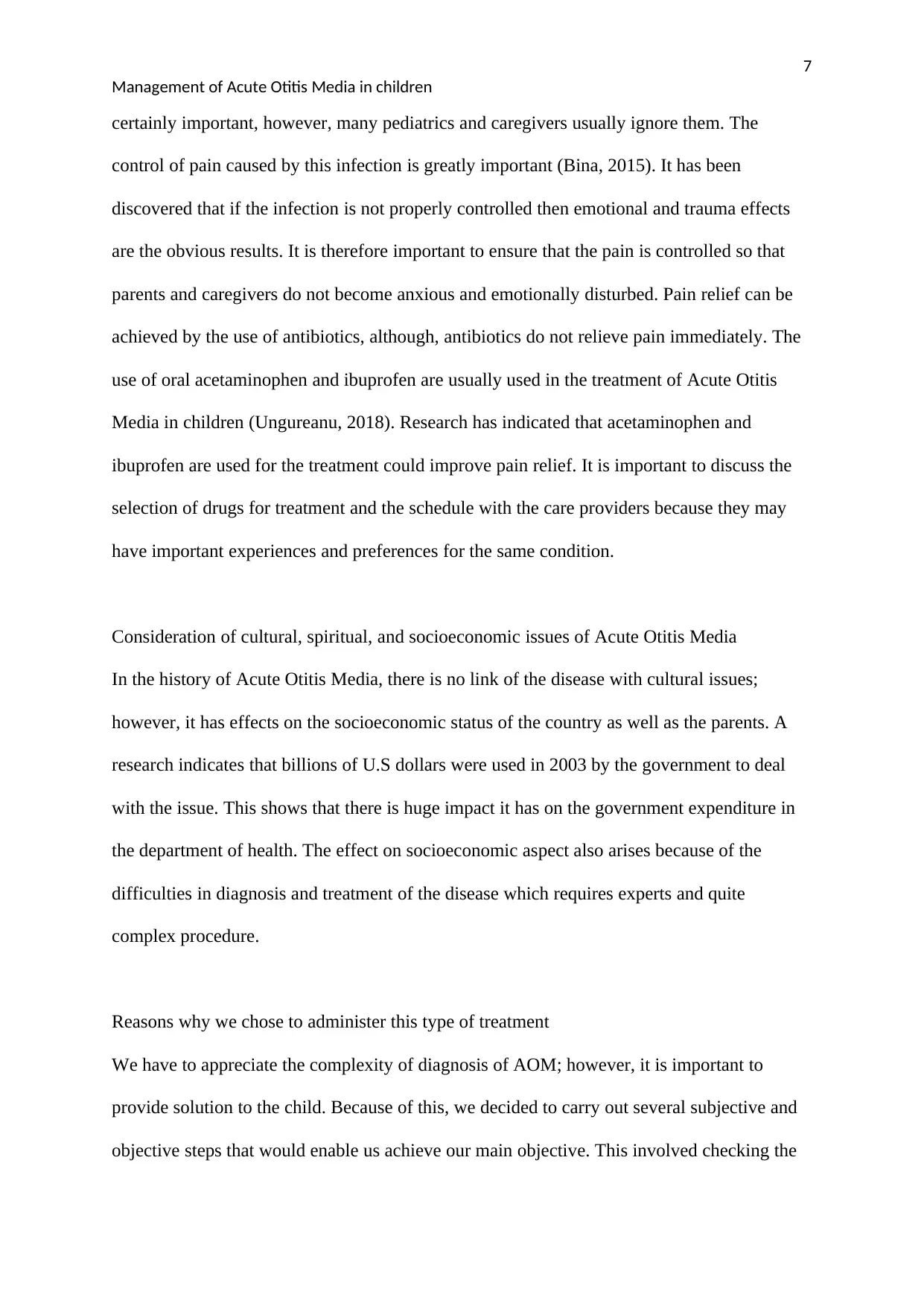
7
Management of Acute Otitis Media in children
certainly important, however, many pediatrics and caregivers usually ignore them. The
control of pain caused by this infection is greatly important (Bina, 2015). It has been
discovered that if the infection is not properly controlled then emotional and trauma effects
are the obvious results. It is therefore important to ensure that the pain is controlled so that
parents and caregivers do not become anxious and emotionally disturbed. Pain relief can be
achieved by the use of antibiotics, although, antibiotics do not relieve pain immediately. The
use of oral acetaminophen and ibuprofen are usually used in the treatment of Acute Otitis
Media in children (Ungureanu, 2018). Research has indicated that acetaminophen and
ibuprofen are used for the treatment could improve pain relief. It is important to discuss the
selection of drugs for treatment and the schedule with the care providers because they may
have important experiences and preferences for the same condition.
Consideration of cultural, spiritual, and socioeconomic issues of Acute Otitis Media
In the history of Acute Otitis Media, there is no link of the disease with cultural issues;
however, it has effects on the socioeconomic status of the country as well as the parents. A
research indicates that billions of U.S dollars were used in 2003 by the government to deal
with the issue. This shows that there is huge impact it has on the government expenditure in
the department of health. The effect on socioeconomic aspect also arises because of the
difficulties in diagnosis and treatment of the disease which requires experts and quite
complex procedure.
Reasons why we chose to administer this type of treatment
We have to appreciate the complexity of diagnosis of AOM; however, it is important to
provide solution to the child. Because of this, we decided to carry out several subjective and
objective steps that would enable us achieve our main objective. This involved checking the
Management of Acute Otitis Media in children
certainly important, however, many pediatrics and caregivers usually ignore them. The
control of pain caused by this infection is greatly important (Bina, 2015). It has been
discovered that if the infection is not properly controlled then emotional and trauma effects
are the obvious results. It is therefore important to ensure that the pain is controlled so that
parents and caregivers do not become anxious and emotionally disturbed. Pain relief can be
achieved by the use of antibiotics, although, antibiotics do not relieve pain immediately. The
use of oral acetaminophen and ibuprofen are usually used in the treatment of Acute Otitis
Media in children (Ungureanu, 2018). Research has indicated that acetaminophen and
ibuprofen are used for the treatment could improve pain relief. It is important to discuss the
selection of drugs for treatment and the schedule with the care providers because they may
have important experiences and preferences for the same condition.
Consideration of cultural, spiritual, and socioeconomic issues of Acute Otitis Media
In the history of Acute Otitis Media, there is no link of the disease with cultural issues;
however, it has effects on the socioeconomic status of the country as well as the parents. A
research indicates that billions of U.S dollars were used in 2003 by the government to deal
with the issue. This shows that there is huge impact it has on the government expenditure in
the department of health. The effect on socioeconomic aspect also arises because of the
difficulties in diagnosis and treatment of the disease which requires experts and quite
complex procedure.
Reasons why we chose to administer this type of treatment
We have to appreciate the complexity of diagnosis of AOM; however, it is important to
provide solution to the child. Because of this, we decided to carry out several subjective and
objective steps that would enable us achieve our main objective. This involved checking the
Paraphrase This Document
Need a fresh take? Get an instant paraphrase of this document with our AI Paraphraser
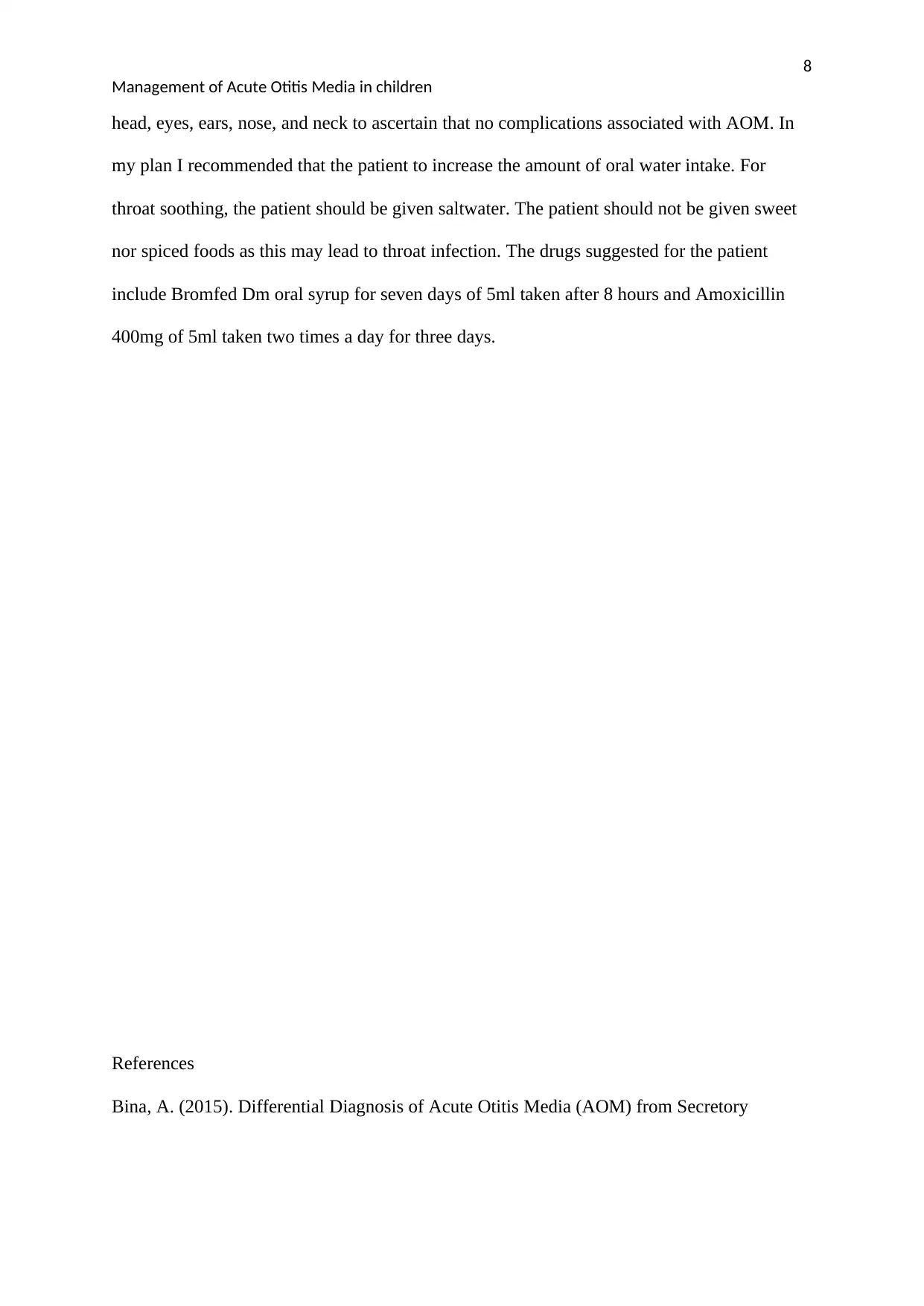
8
Management of Acute Otitis Media in children
head, eyes, ears, nose, and neck to ascertain that no complications associated with AOM. In
my plan I recommended that the patient to increase the amount of oral water intake. For
throat soothing, the patient should be given saltwater. The patient should not be given sweet
nor spiced foods as this may lead to throat infection. The drugs suggested for the patient
include Bromfed Dm oral syrup for seven days of 5ml taken after 8 hours and Amoxicillin
400mg of 5ml taken two times a day for three days.
References
Bina, A. (2015). Differential Diagnosis of Acute Otitis Media (AOM) from Secretory
Management of Acute Otitis Media in children
head, eyes, ears, nose, and neck to ascertain that no complications associated with AOM. In
my plan I recommended that the patient to increase the amount of oral water intake. For
throat soothing, the patient should be given saltwater. The patient should not be given sweet
nor spiced foods as this may lead to throat infection. The drugs suggested for the patient
include Bromfed Dm oral syrup for seven days of 5ml taken after 8 hours and Amoxicillin
400mg of 5ml taken two times a day for three days.
References
Bina, A. (2015). Differential Diagnosis of Acute Otitis Media (AOM) from Secretory
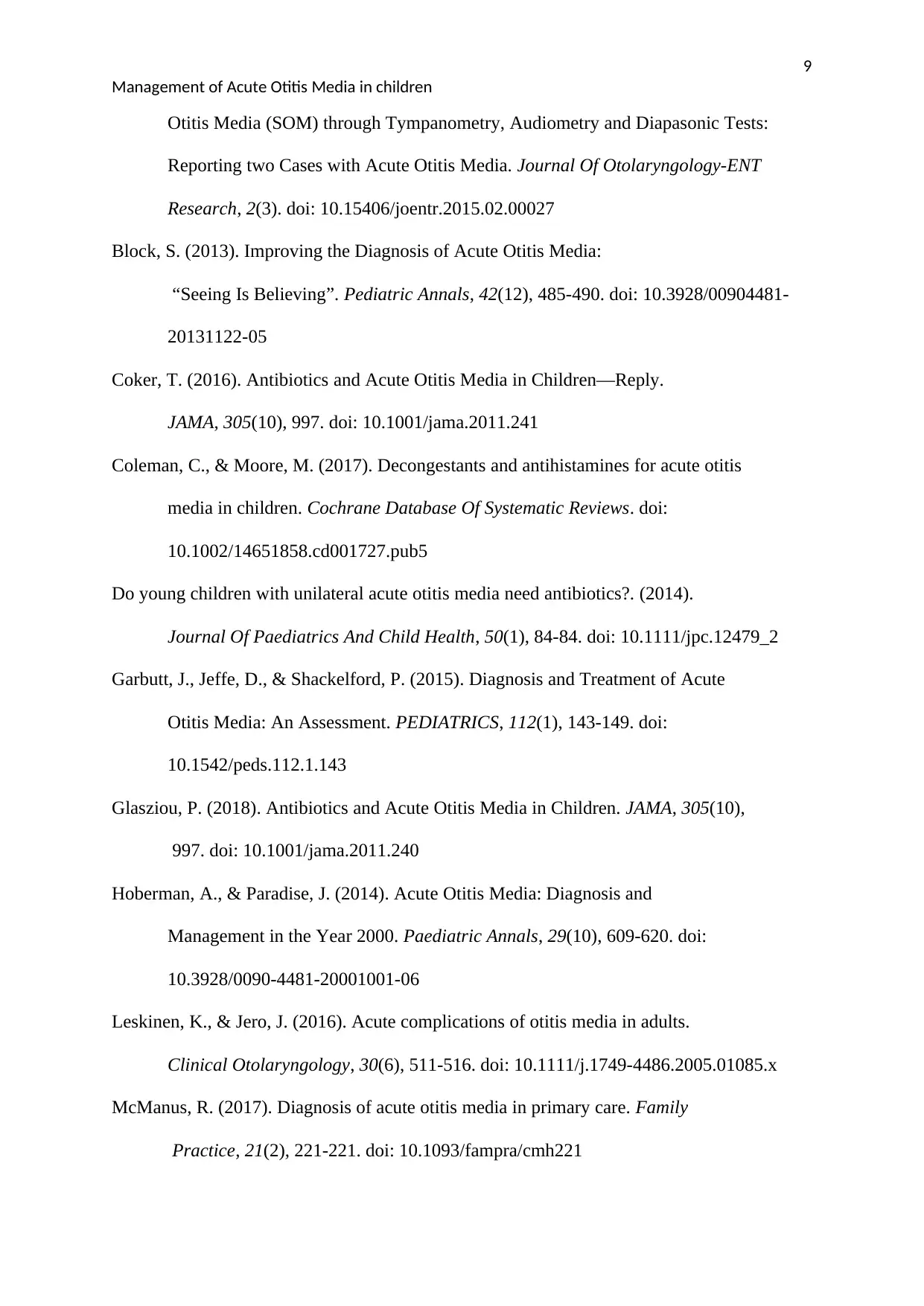
9
Management of Acute Otitis Media in children
Otitis Media (SOM) through Tympanometry, Audiometry and Diapasonic Tests:
Reporting two Cases with Acute Otitis Media. Journal Of Otolaryngology-ENT
Research, 2(3). doi: 10.15406/joentr.2015.02.00027
Block, S. (2013). Improving the Diagnosis of Acute Otitis Media:
“Seeing Is Believing”. Pediatric Annals, 42(12), 485-490. doi: 10.3928/00904481-
20131122-05
Coker, T. (2016). Antibiotics and Acute Otitis Media in Children—Reply.
JAMA, 305(10), 997. doi: 10.1001/jama.2011.241
Coleman, C., & Moore, M. (2017). Decongestants and antihistamines for acute otitis
media in children. Cochrane Database Of Systematic Reviews. doi:
10.1002/14651858.cd001727.pub5
Do young children with unilateral acute otitis media need antibiotics?. (2014).
Journal Of Paediatrics And Child Health, 50(1), 84-84. doi: 10.1111/jpc.12479_2
Garbutt, J., Jeffe, D., & Shackelford, P. (2015). Diagnosis and Treatment of Acute
Otitis Media: An Assessment. PEDIATRICS, 112(1), 143-149. doi:
10.1542/peds.112.1.143
Glasziou, P. (2018). Antibiotics and Acute Otitis Media in Children. JAMA, 305(10),
997. doi: 10.1001/jama.2011.240
Hoberman, A., & Paradise, J. (2014). Acute Otitis Media: Diagnosis and
Management in the Year 2000. Paediatric Annals, 29(10), 609-620. doi:
10.3928/0090-4481-20001001-06
Leskinen, K., & Jero, J. (2016). Acute complications of otitis media in adults.
Clinical Otolaryngology, 30(6), 511-516. doi: 10.1111/j.1749-4486.2005.01085.x
McManus, R. (2017). Diagnosis of acute otitis media in primary care. Family
Practice, 21(2), 221-221. doi: 10.1093/fampra/cmh221
Management of Acute Otitis Media in children
Otitis Media (SOM) through Tympanometry, Audiometry and Diapasonic Tests:
Reporting two Cases with Acute Otitis Media. Journal Of Otolaryngology-ENT
Research, 2(3). doi: 10.15406/joentr.2015.02.00027
Block, S. (2013). Improving the Diagnosis of Acute Otitis Media:
“Seeing Is Believing”. Pediatric Annals, 42(12), 485-490. doi: 10.3928/00904481-
20131122-05
Coker, T. (2016). Antibiotics and Acute Otitis Media in Children—Reply.
JAMA, 305(10), 997. doi: 10.1001/jama.2011.241
Coleman, C., & Moore, M. (2017). Decongestants and antihistamines for acute otitis
media in children. Cochrane Database Of Systematic Reviews. doi:
10.1002/14651858.cd001727.pub5
Do young children with unilateral acute otitis media need antibiotics?. (2014).
Journal Of Paediatrics And Child Health, 50(1), 84-84. doi: 10.1111/jpc.12479_2
Garbutt, J., Jeffe, D., & Shackelford, P. (2015). Diagnosis and Treatment of Acute
Otitis Media: An Assessment. PEDIATRICS, 112(1), 143-149. doi:
10.1542/peds.112.1.143
Glasziou, P. (2018). Antibiotics and Acute Otitis Media in Children. JAMA, 305(10),
997. doi: 10.1001/jama.2011.240
Hoberman, A., & Paradise, J. (2014). Acute Otitis Media: Diagnosis and
Management in the Year 2000. Paediatric Annals, 29(10), 609-620. doi:
10.3928/0090-4481-20001001-06
Leskinen, K., & Jero, J. (2016). Acute complications of otitis media in adults.
Clinical Otolaryngology, 30(6), 511-516. doi: 10.1111/j.1749-4486.2005.01085.x
McManus, R. (2017). Diagnosis of acute otitis media in primary care. Family
Practice, 21(2), 221-221. doi: 10.1093/fampra/cmh221
⊘ This is a preview!⊘
Do you want full access?
Subscribe today to unlock all pages.

Trusted by 1+ million students worldwide
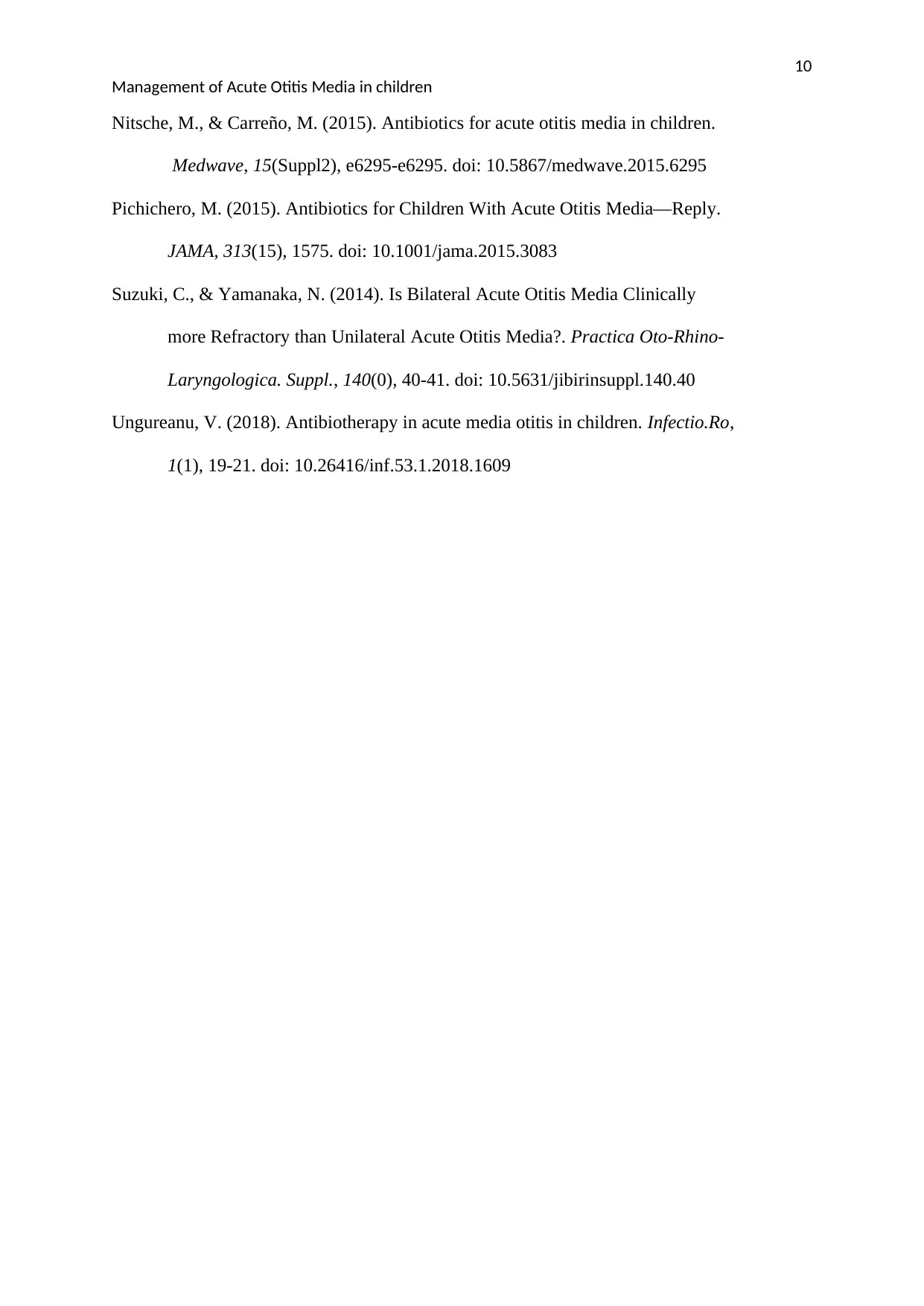
10
Management of Acute Otitis Media in children
Nitsche, M., & Carreño, M. (2015). Antibiotics for acute otitis media in children.
Medwave, 15(Suppl2), e6295-e6295. doi: 10.5867/medwave.2015.6295
Pichichero, M. (2015). Antibiotics for Children With Acute Otitis Media—Reply.
JAMA, 313(15), 1575. doi: 10.1001/jama.2015.3083
Suzuki, C., & Yamanaka, N. (2014). Is Bilateral Acute Otitis Media Clinically
more Refractory than Unilateral Acute Otitis Media?. Practica Oto-Rhino-
Laryngologica. Suppl., 140(0), 40-41. doi: 10.5631/jibirinsuppl.140.40
Ungureanu, V. (2018). Antibiotherapy in acute media otitis in children. Infectio.Ro,
1(1), 19-21. doi: 10.26416/inf.53.1.2018.1609
Management of Acute Otitis Media in children
Nitsche, M., & Carreño, M. (2015). Antibiotics for acute otitis media in children.
Medwave, 15(Suppl2), e6295-e6295. doi: 10.5867/medwave.2015.6295
Pichichero, M. (2015). Antibiotics for Children With Acute Otitis Media—Reply.
JAMA, 313(15), 1575. doi: 10.1001/jama.2015.3083
Suzuki, C., & Yamanaka, N. (2014). Is Bilateral Acute Otitis Media Clinically
more Refractory than Unilateral Acute Otitis Media?. Practica Oto-Rhino-
Laryngologica. Suppl., 140(0), 40-41. doi: 10.5631/jibirinsuppl.140.40
Ungureanu, V. (2018). Antibiotherapy in acute media otitis in children. Infectio.Ro,
1(1), 19-21. doi: 10.26416/inf.53.1.2018.1609
1 out of 10
Related Documents
Your All-in-One AI-Powered Toolkit for Academic Success.
+13062052269
info@desklib.com
Available 24*7 on WhatsApp / Email
![[object Object]](/_next/static/media/star-bottom.7253800d.svg)
Unlock your academic potential
Copyright © 2020–2025 A2Z Services. All Rights Reserved. Developed and managed by ZUCOL.





